X-RAY RUNS: Apply for Beamtime
2017 Nov 1 - Dec 21
2018 Feb 7 - Apr 3
2018 Proposal/BTR deadline: 12/1/17
2018 Apr 11 - Jun 4
2018 Proposal/BTR deadline: 2/1/18
_______________________________________________
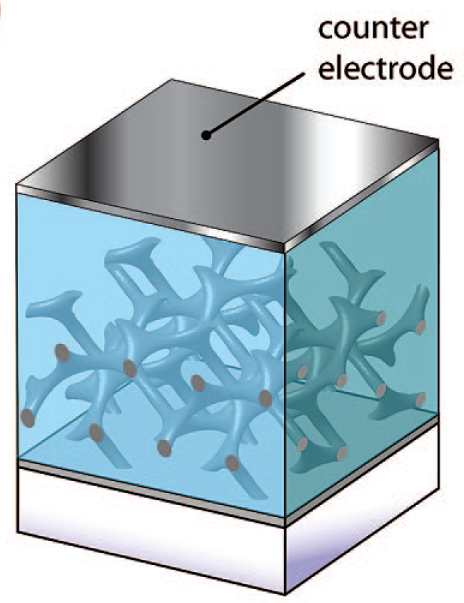
A Bicontinuous Double Gyroid Hybrid Solar Cell
Converting light to electrical energy in solar cells depends sensitively on nanometer-scale structures. This group reports the first successful solar cell made from an ordered bicontinuous gyroid semiconducting network. The highly ordered pore structure is filled with an organic hole transporting material. The first such exhibited a promising 1.7% power conversion efficiency.
Read more... (html)
11/20/2009
_______________________________________________
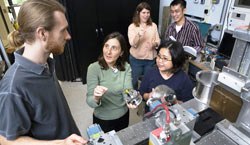
Of Waltzing Proteins and Whispering RNA
In the Spring 2009 issue of the College of Engineering Magazine, graduate student Sourish Basu interviews Applied and Engineering Physics Associate Professor Lois Pollack about her passion to seek answers to questions at the forefront of molecular biology.
Read more... (html)
_______________________________________________

X-rays Track Tree-Ring Growth Anomalies
Experts Charlotte Pearson and Sturt Manning, from the Cornell Tree-Ring Laboratory, worked with CHESS staff using x-ray fluorescence to record the chemical composition of individual tree-rings for historical data. Samples of Juniper wood were borrowed from the Aegean Dendrochronology Project archives to study the growth anomalies seen at relative ring 854.
Read more... (html)
11/20/2009
_______________________________________________
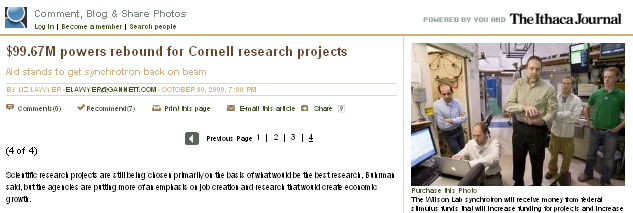
$99.67M Powers Cornell Projects
(Ithaca Journal, October 30, 2009)
Journalist Liz Lawyer reports on how U.S. Federal Stimulus Program (ARRA) funds are rejuvenating research on the Cornell campus, using CHESS as an example of a program receiving three grants totaling $19 million. Her article coincided with an x-ray data collection run at the A2 station of Cornell Professor Matt Miller and his graduate group. Miller is also receiving stimulus funds and is using them to hire graduate students for ongoing x-ray studies of advanced composite materials.
Lightsources.org featured the story: http://www.lightsources.org/cms/
The original is found at the Ithaca Journal
website
Archived here: (pdf)
11/02/2009
_______________________________________________
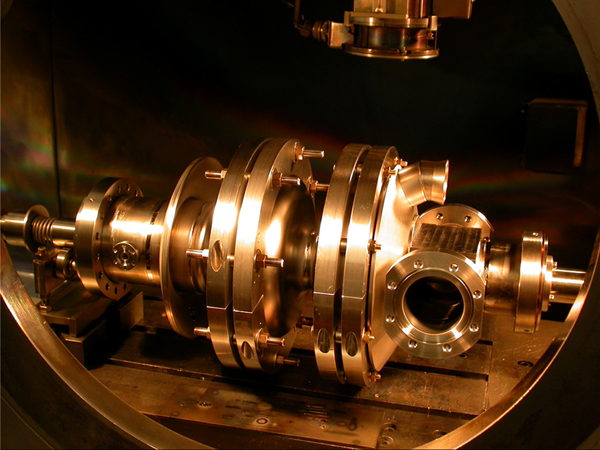
America's Accelerator Future
In his opening remarks at the October 26-28, 2009 symposium and workshop on “Accelerators for America’s Future” in Washington D.C., Dennis Kovar, Associate Director of the Office of Science for High Energy Physics, stressed that particle accelerators are major tools for basic and applied sciences and serve the nation and society in many, many ways. Among them he highlighted medical, security and industrial applications, as well as to point out that these “tools” – once the domain of only the physical sciences - are now central resources for advances in biological, chemical and, actually, all the scientific disciplines. As part of its mission to build and operator the Nation’s major user accelerator facilities, the Department of Energy hosted the three day workshop so that it could better understand opportunities for advancements in accelerator technologies and the impacts these advancements could have in basic and applied sciences.
Read more... (html)
10/28/2009
_______________________________________________
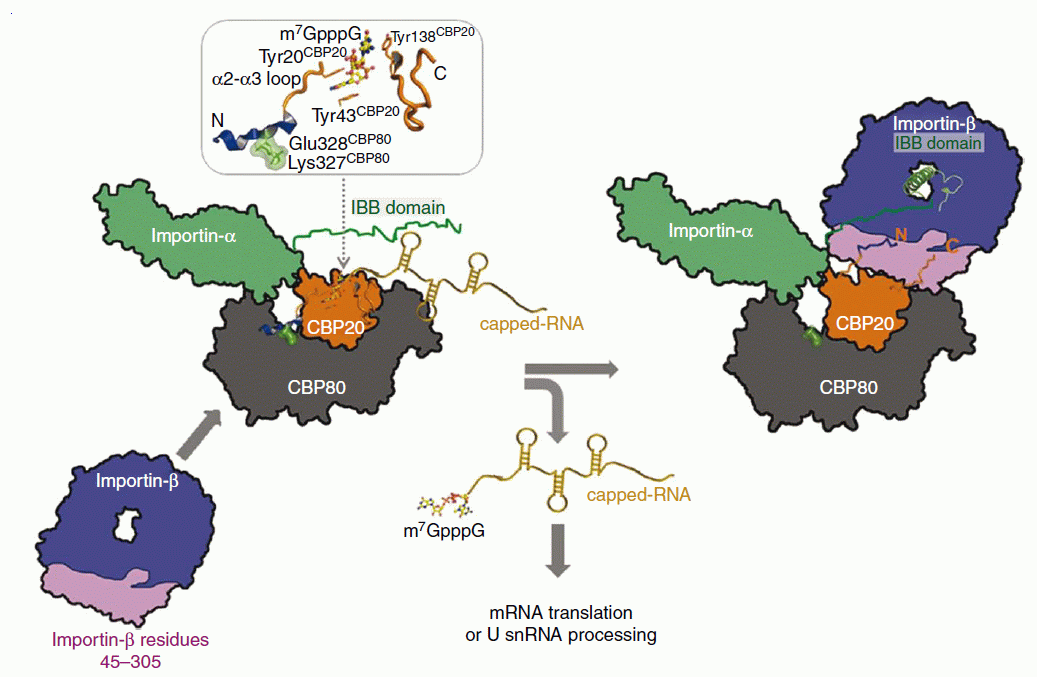
Cerione group's work reveals details of RNA processing
The messenger RNA transcribed from DNA must be modified before it can be used to make proteins. This modification involves several steps, including capping and splicing of the mRNA, as well as transport of species into and out of the nucleus. Rick Cerione and co-workers (Cornell) have now used a combination of X-ray crystallographic, small-angle scattering (SAXS), and biochemical experiments to study the interaction between the cap-binding complex (CBC), which regulates mRNA splicing, and the importin-α and -β proteins (Dias et al., Nature Struct. Mol. Biol. (2009) 16, 930-937).
The importins regulate the transport of the CBC into the nucleus, the binding of capped mRNA to the CBC, and the subsequent release of mRNA from the complex after it is exported from the nucleus. The crystal structure of a CBC-importin-α complex showed in detail how these two species bind each other, while biochemical data plus a previous importin-α-importin-β crystal structure resulted in construction of a model of the complete CBC-importin-α-importin-β complex. SAXS data confirmed the plausibility of the model. The model, in turn, suggested a mechanism for the release of mRNA from the complex when importin-β binds, as shown in the figure (CBP20 and CBP80 are the cap-binding and regulatory domains, respectively, of CBC). The boxed inset shows the predicted binding of an mRNA cap to CBP20.
Read more... (html)
10/27/2009
_______________________________________________
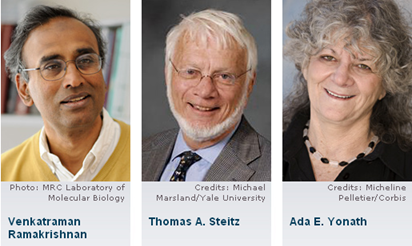
Ribosome Studies Awarded 2009 Nobel Prize in Chemistry
The Cornell High Energy Synchrotron Source (CHESS) congratulates Ada E. Yonath (Weitzman Institute, Israel), Thomas A Steitz (Yale University, USA, and Venkatraman Ramakrishnan (MRC Laboratory of Molecular Biology, UK) for receipt of the 2009 Nobel Prize in Chemistry for their pioneering studies elucidating the structure and function of "one of life's core processes: the ribosome's translation of DNA information into life". The Royal Swedish Academy noted the importance of synchrotron x-ray crystallography in providing atomic-level structural information of the ribosome. These scientists led independent efforts to discover the three-dimensional positions of hundreds of thousands of individual atoms that together comprise the ribosome.
10/09/2009
_______________________________________________
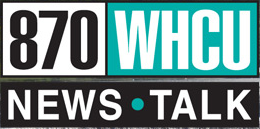
WHCU Morning Newswatch Podcasts CU Linac
X-ray Machine
Sept. 23, 2009
Associate Director of Cornell High Energy Synchrotron Source, Don Bilderback, details Cornell's proposal to build a half-billion dollar X-ray machine.
What is an Energy Recovery Linac X-ray
Machine?
It will be a much brighter source of x-rays
for the future than any present day x-ray source. It will be the
world’s most advanced x-ray machine for decades to come. The
National Science Foundation has sponsored Cornell’s existing
synchrotron x-ray facility under upper Alumni field on the Cornell
campus. It has been used for many years as a high intensity x-ray
source to study the structure of matter down to the atomic scale.
This is important for physics, biology, medicine, chemistry and
materials science, and lets us do things that are not possible with
more conventional x-ray equipment. Scientist from Cornell and across
the world bring their scientific projects to our synchrotron
laboratory to shine our intense synchrotron x-rays onto their
samples. They want to examine how the atoms are arranged in their
specimens. Ultimately this leads to a better understanding of how
matter functions.
See more information: http://news.chess.cornell.edu/articles/2009/WHCUInterview.html
WHCU Morning Newswatch Podcast (MP3)*
*does not work with Internet Explorer*
09/24/2009
_______________________________________________

Figure from: www.Recovery.gov
Stimulus Funds Help Synchrotron Research
Lightsources.org covered an article by the Cornell Chronicle author Anne Ju describing ARRA stimulus funds aiding the CHESS and the ERL development efforts at Cornell. She provides links to other stimulus efforts at Cornell, as well. She wrote: “Nearly $19 million allocated this year through the American Recovery and Reinvestment Act (ARRA) will support research at Wilson Synchrotron Laboratory, including the Cornell High Energy Synchrotron Source (CHESS), the Cornell Electron Storage Ring (CESR) and ongoing efforts to plan and build a new linear accelerator called the Energy Recovery Linac.” "The funds are allowing us to hire a few people and, more importantly, allow us to retain our superb staff," said Sol Gruner, CHESS director.
See the Chronicle article here: http://www.news.cornell.edu/stories/Sept09/CESRstimulus.html
and the www.lightsource.org home page with coverage here: http://www.lightsources.org/cms/?pid=1003715
09/15/2009
_______________________________________________

Hidden treasure: Technique reveals buried image in famed illustrator's painting
Visualizing a missing N.C. Wyeth painting using x-ray fluorescence is the topic of a keynote address by Dr. Jennifer L. Mass at the August 19th, 2009 American Chemical Society (ACS) meeting symposium, "Practical Applications of Surface Chemistry: Art and Sensing Applications." In this presentation, Mass, from the Department of Art Conservation at the University of Delaware, recounts work enabled by a collaboration with scientists at CHESS, the Cornell High Energy Synchrotron Source, to develop a confocal x-ray fluorescence microscope to examine the chemistry – and ultimately see the color palette – of layers of paint buried beneath a later portrait.
Read more here... (html)
08/21/2009
_______________________________________________
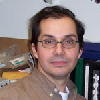
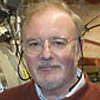
(Left - Ernest Fontes, Right - Maury Tigner)
At AAAS, Cornell physicists stress need to maintain U.S. prominence in accelerator science
Cornell physicists Maury Tigner and Ernest Fontes spoke on the potential and future of accelerator-based science at the 2009 annual meeting of the American Association for the Advancement of Science in Chicago, Ill.
See the Cornell Chronicle research highlight here... http://www.news.cornell.edu/stories/Feb09/aaas.TignerFontes.html
or (pdf)
02/18/2009
_______________________________________________
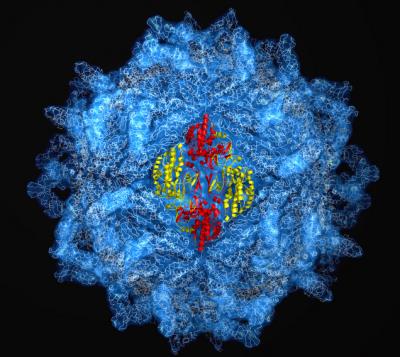
News media channels lit up yesterday (Feb. 17, 2009) with stunning images and stories about a three year project by Rice University scientists to map out a virus coating containing over 5 million atoms. CHESS was used to collect diffraction images necessary create this detailed picture published in the Feb. 16 issue of the journal Proceedings of the National Academy of Sciences. High resolution pictures like these will ultimately help researchers understand the structure and function of viruses and uncover ways to fight viral infections.
02/18/2009
_______________________________________________
CHESS Ph. D. Thesis Prize Opens for Nominations
CHESS is now accepting nominees for the 4th Annual CHESS Thesis Prize of $1,000. The award will go to a student receiving a PhD or Masters degree during the year March 2008 to March 2009. The thesis work must be based in part on X-ray research done using the Cornell High Energy Synchrotron Source.
Read more here... (html)
02/10/2009
_______________________________________________
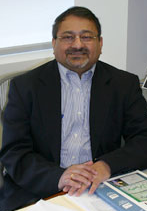
Scientist First in World to Unravel the Molecular Structure of the Key Breast Cancer Target Enzyme that Makes All Estrogens
The molecular details of Aromatase, the key enzyme required for the body to make estrogen, are no longer a mystery thanks to the structural biology work done by the Ghosh lab at the Hauptman-Woodward Medical Research Institute (HWI) in Buffalo, New York. Dr. Debashis Ghosh's solution of the three-dimensional structure of aromatase is the first time that scientists have been able to visualize the mechanism of synthesizing estrogen.
Read more here... (html)
02/02/2009
_______________________________________________
